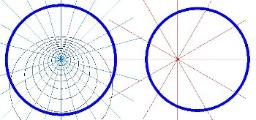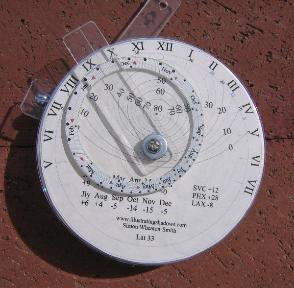| THE PLANISPHERIC ASTROLABE |
Having posessed several astrolabes for many years, and having used them on my travels until the TSA (Transportation Security
Administration) at the airports became concerned that the astrolabe was some deadly weapon, I have always had a fondness for the
instrument. Developed largely by Arab influence, the astrolabe is truly an amazing model of the earth, sun, ecliptic, and the universe.
NOTE: Some astrolabes merely measure angles (nautical astrolabe). What is discussed here is the astrolabe that measures time
by the sun's height above the horizon (altitude). To do that, one of several geometric projections are used, and those projections are
converted to trigonometry for tabular (as in Excel) or programmed (as in DeltaCAD) use. There are several projections, the most
commonly used is the planispheric projection, which is what is used here.
The most common astrolabe is the planispheric astrolabe, this models the universe onto the planet's equatorial plane, using a
simple stereographic projection. Another is the Saphea projection which models the entire universe onto a vertical great circle, and
thus becomes somewhat latitude independent.
My supplement is how to build an astrolabe using simple geometry, using the planispheric model. The article is in PDF format, and
uses TurboCAD as a drafting CAD program. However the principle is so simple that a sheet of paper, a protractor, a ruler and a
drafting compass is all that is needed. While the fixed plate of altitudes (almucanters), or climate plate is latitude dependant, the rete
(rotating plate) is latitude independent. This five page article covers the entire design process. Check the DeltaCAD astrolabe macro
and the general spreadsheet also for astrolabe formula. The DeltaCAD macro (including the astrolabe) is, I believe, the first readily
available source code for you to build your own astrolabes, encompassing ALL elements of the astrolabe, similarly with the Excel
version. Since then, others have followed. Illustrating Time's Shadow covers the astrolabe in even more detail.
A link to the CAD (TurboCAD) TCW model for all the graphics in the article, it is
designed for latitude 33. Unlike the DeltaCAD macro, this is not automated.
A search for "astrolabe" on the internet is somewhat frustrating, a search for "planispheric astrolabe" or "astrolabe catholicum" is more
productive. There is little written on the astrolabe design.
However there is a good article on stereographic projection for the climate plate at:
http://www.math.ubc.ca/~cass/courses/m309-01a/montero/math309project.html
Also, Mr Morrison has written a definitive work on astrolabes.
Commercially available astrolabes can be acquired from
Norman Greene, 1215 4th St., Berkeley, CA, 94710
http://www.puzzlering.net/astrolabe.html
Administration) at the airports became concerned that the astrolabe was some deadly weapon, I have always had a fondness for the
instrument. Developed largely by Arab influence, the astrolabe is truly an amazing model of the earth, sun, ecliptic, and the universe.
NOTE: Some astrolabes merely measure angles (nautical astrolabe). What is discussed here is the astrolabe that measures time
by the sun's height above the horizon (altitude). To do that, one of several geometric projections are used, and those projections are
converted to trigonometry for tabular (as in Excel) or programmed (as in DeltaCAD) use. There are several projections, the most
commonly used is the planispheric projection, which is what is used here.
The most common astrolabe is the planispheric astrolabe, this models the universe onto the planet's equatorial plane, using a
simple stereographic projection. Another is the Saphea projection which models the entire universe onto a vertical great circle, and
thus becomes somewhat latitude independent.
My supplement is how to build an astrolabe using simple geometry, using the planispheric model. The article is in PDF format, and
uses TurboCAD as a drafting CAD program. However the principle is so simple that a sheet of paper, a protractor, a ruler and a
drafting compass is all that is needed. While the fixed plate of altitudes (almucanters), or climate plate is latitude dependant, the rete
(rotating plate) is latitude independent. This five page article covers the entire design process. Check the DeltaCAD astrolabe macro
and the general spreadsheet also for astrolabe formula. The DeltaCAD macro (including the astrolabe) is, I believe, the first readily
available source code for you to build your own astrolabes, encompassing ALL elements of the astrolabe, similarly with the Excel
version. Since then, others have followed. Illustrating Time's Shadow covers the astrolabe in even more detail.
A link to the CAD (TurboCAD) TCW model for all the graphics in the article, it is
designed for latitude 33. Unlike the DeltaCAD macro, this is not automated.
A search for "astrolabe" on the internet is somewhat frustrating, a search for "planispheric astrolabe" or "astrolabe catholicum" is more
productive. There is little written on the astrolabe design.
However there is a good article on stereographic projection for the climate plate at:
http://www.math.ubc.ca/~cass/courses/m309-01a/montero/math309project.html
Also, Mr Morrison has written a definitive work on astrolabes.
Commercially available astrolabes can be acquired from
Norman Greene, 1215 4th St., Berkeley, CA, 94710
http://www.puzzlering.net/astrolabe.html


| A video online of the Astrolabe is here |